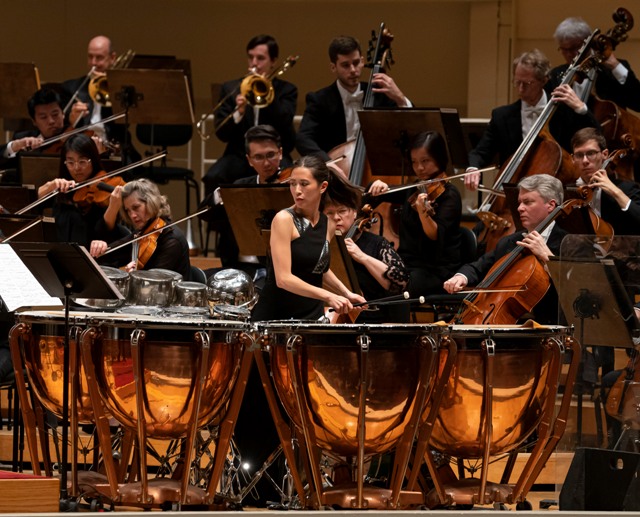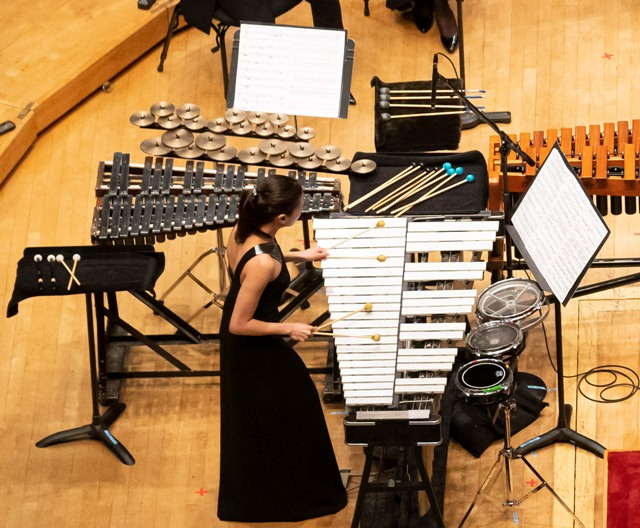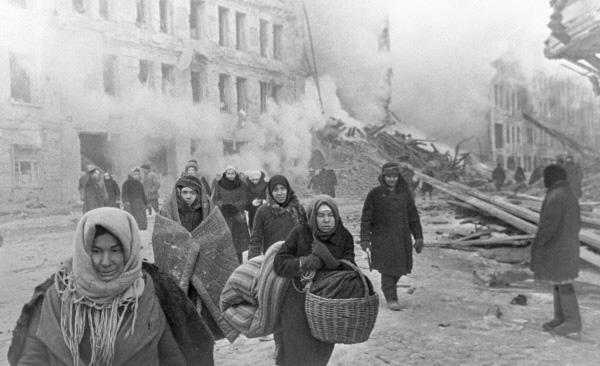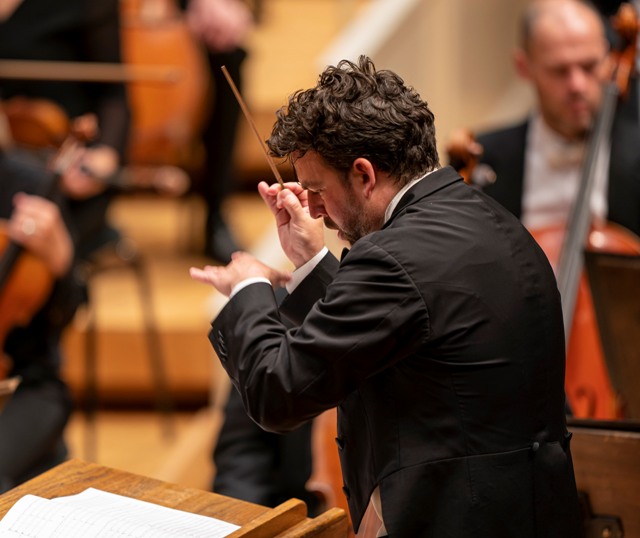Rising conductor shows his mettle with CSO in Shostakovich symphony, concerto premiere

Timpani are among the percussion instruments Cynthia Yeh played in Avner Dorman’s concerto ‘Eternal Rhythm’ with the Chicago Symphony Orchestra. (Photos by Todd Rosenberg)
Review: James Gaffigan conducts Chicago Symphony with Cynthia Yeh, percussion, in U.S. premiere of Avner Dorman concerto.
By Nancy Malitz
James Gaffigan won the Sir Georg Solti International Conducting Competition at age 25. Now at 40, he is checking off debuts with the world’s major orchestras and opera companies with work that is typically vibrant and rhythmically vigorous. He has been an advocate of Israeli-born American composer Avner Dorman, whose high-voltage percussion concerto “Frozen in Time” Gaffigan brought to the Grant Park Orchestra back in 2012 with an Austrian soloist.
Flash forward to the first weekend of October, when Gaffigan offered a substantial program with the Chicago Symphony Orchestra as the first guest conductor of the new season. Both works on Gaffigan’s program were lengthy and complex with particular challenges.
Shostakovich’s massive Symphony No. 8 is a cry from the heart of agony in wartime 1943 that evanesces into the mystifying, almost giddy grace-note sentiment that “I’m still here.” Dorman’s 2018 percussion concerto “Eternal Rhythm” was getting its U.S. debut at the hands of CSO principal percussionist Cynthia Yeh on a bevy of struck instruments including pitched tom-toms, tam-tams, tiny antique cymbals (crotales), marimba, vibraphone and timpani. The concerto launches as if rising from the depths of nothingness, tinged with the quiet shimmer of crotales and glockenspiel, and soon sets Yeh to wildly undulating mallet work and drumming.
On paper, Dorman’s permutations look alive, improvisatory, with Balinese gamelan and Bach among strong influences. It’s hypnotically repetitive music that mutates easily and seems to suggest a spiral naturally upward and outward toward greater mystery and, perhaps, the rhythm of the infinite. But the concerto sounded tentative at the Oct. 3 first performance, as if the conductor, orchestra and Yeh were still focused on integrating the intricacies of its rhythmic footwork, and therefore not quite free to dance.

Yeh moved among several stations with different instrumental arrays including vibraphone, glockenspiel, marimba and crotales, which are tiny cymbals.
One of the five movements gives the soloist the option to intone vocally, as a cantor would, some ancient Hebrew words on the nature of death in the everlasting universe. That text comes as a bolt of revelation at the concerto’s pivot point. These concerts marked the world premiere of the “unsung” version. Yeh just played, without singing. Was this option offered as an afterthought by the composer? It seemed that something was missing. Still, the overall impression that the concerto left was of a distinctive, authentically American voice imbued with appealing threads of Gershwin, Copland, Bernstein, Brubeck and living composers Steve Reich and John Corigliano (Dorman’s teacher) in his DNA, without directly imitating any of them.
The Shostakovich Eighth Symphony had the solid advantage that time and familiarity bring in overcoming inherent performance challenges. The structure of the Eighth can be baffling, with its massive marches, brutal onslaughts and almost sinister contrasts and disruptions. But what can seem counter-intuitive about this piece made perfect sense as Gaffigan shaped it. As for the orchestra in its brass-crowned, paint-peeling glory – and it was all that – the effect of fragile, lone threads of melody from a few wind players, floating upward in an aftermath of stillness, was just as mesmerizing at the other extreme. Scott Hostetler’s plaintive English horn solo came as a shell-shocked lone voice at the end of the ferocious first movement, as if by one unsure he is alive amid so much death. It brought a hush to the house. There were likewise strident and painfully soulful moments from bassoon and contrabassoon, piccolo and flute, really every section in its turn throughout.

Shostakovich’s Eighth Symphony was written at the height of World War II, when the citizens of Leningrad endured extreme hardship. (RIA Novosti Archive)
Chicago audiences have been treated to quite a lot of Shostakovich in recent years. Muti opened the current season with the Sixth Symphony, and in September 2018 Irina Shostakovich, the composer’s widow, was on hand for Muti-led performances of the Thirteenth Symphony, based on Yevtushenko’s poem “Babi Yar,” which recounts the 1941 Nazi massacre of Russian Jews in a ravine outside Kiev. Gennady Rozhdestvensky, Yuri Temirkanov and Jaap Van Zweden have all conducted Shostakovich here since 2014. And later this season (March 20 and 22), Russian conductor Valery Gergiev returns to the CSO to conduct Shostakovich’s Seventh Symphony, the so called “Leningrad,” written in 1941 while the city was under siege.

Composer Avner Dorman, conductor James Gaffigan and soloist Cynthia Yeh take their bows with the Chicago Symphony at the U.S. premiere of Dorman’s ‘Eternal Rhythm.’
Gaffigan is the distinct junior in this company of maestros, but his Shostakovich rested comfortably in the context. Gaffigan’s career is clearly ascendant, with performances already under his belt at the Met Opera, Chicago’s Lyric, and major orchestras on both sides of the pond. His work with the CSO seemed authoritative and collegial, his sensibility for the music of his own generation readily apparent. Actually, Dorman is older than Gaffigan by four years, but the composer and the conductor are on similar trajectories.
Related Links:
- Profile of Cynthia Yeh as she prepared for her solo turn: Read it at CSO Sounds & Stories
- Sample Avner Dorman’s music: Watch and listen at AvnerDormanMusic.com
- Check out James Gaffigan’s conducting calendar: Find it at JamesGaffigan.com



Uh-noh. He’s an interesting young conductor, but this is the CSO, not some experimental orchestra. Your enthusiasm is kind, but utterly misplaced.